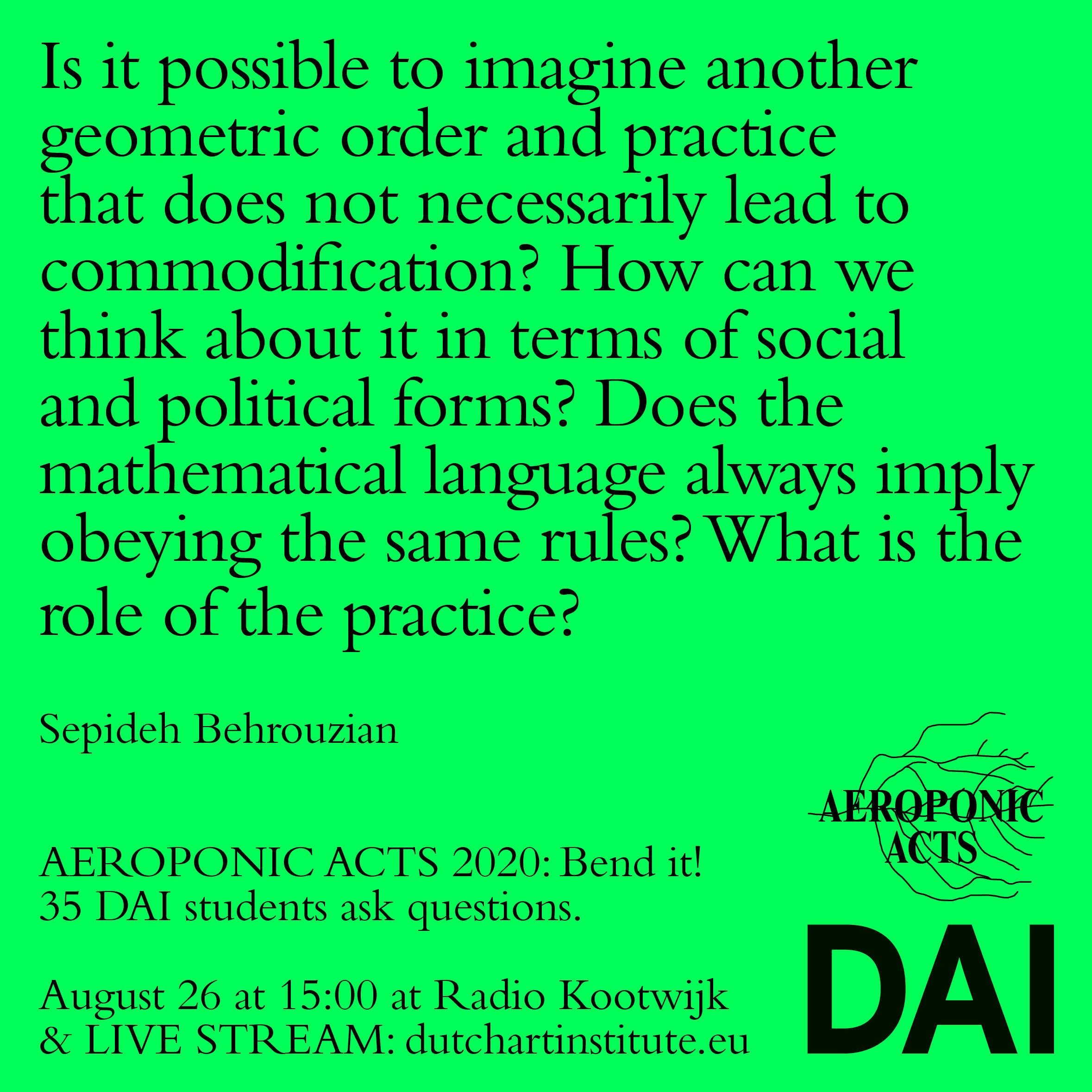Sepideh Behruzian: Circling the Square
‘Aeroponic’ – root systems nourished by air – Acts is the name given to the nomadic Dutch Art Institute’s final Kitchen presentations. Each participant addresses one question.
Here you will find the documentation of Sepideh Behruzian's presentation as filmed by Baha Görkem Yalım. The written report is by Bethany Crawford and it includes a summary of the comments by esteemed guest respondents.
Circling The Square
Sepideh's question: Is it possible to imagine another geometric order and practice that does not necessarily lead to commodification? How can we think about it in terms of social and political forms? Does the mathematical language always imply obeying the same rules? What is the role of the practice?
Sepideh's introduction: The egalitarian property of geometry binds itself to a justification for mass production. A justice in the liberal accessibility to repetitive production can be justified only within this property. However, is it possible to imagine another geometric order and practice that does not necessarily lead to commodification? How can we think about it in terms of social and political forms? Does the mathematical language always imply obeying the same rules? What is the role of the practice?
Bethany's report: To an audience seated in a rhizomatic geometric shape fanning out from the centre, Behruzian reads a text introduced as ‘written in the liminal places of dreams and annotations, from the centre and the margins’. The text outlines ways to reimagine geometry and repetition beyond the capitalist approach of mass production and reproduction. Behruzian references esoteric forms of repetition as a method of entering ego-less and meditative states, questioning how we can look to these techniques to rupture and reconsider ‘another geometric order that does not necessarily lead to commodification’ and as a tool to break down binaries. She looks to the practice of geometric patterning in Islamic architecture, referencing ‘muqarnas’ as a practice of transition rather than finished product. Behruzian complicates linear notions of working towards a finality, and instigates a mode of working with the complexities.
Amal Alhaag noted that her own questions about the presentation enjoyably brought more questions. Alhaag referenced C.K. Raju, an Indian decagonal mathematician, who proposed that geometry was a myth, as in order to rethink the origin myth one has to rethink who our foundational thinkers are. In the architectural sense, she continued, listening to such dense yet fascinating material led to enjoyable moments of stretching the language in thinking ‘muqarnas-ly’.
Amit S. Rai congratulated Behruzian on wonderfully making philosophy. He referenced Alberto Toscano’s first book, and the importance of pointing to other traditions and other cultures in Asia that have different relationships to order and change. Geometry is still rooted in an understanding of representation as fixed and solid, he said, and referred to the question of repetition, reading a passage from Gilles Deleuze’s Difference and Repetition to clarify the social and how the geometric order is what we get habituated into. There was also something creative going on under the surface, he said, returning to Behruzian’s vital questions around the process that constitutes the product, namely the question of capital and how it is changing in its algorithmic phase, evolutionary algorithms and how they change their own programming. He asked: ‘What does that mean for the social? Is something being opened up that we can’t quite see? Where is monstrosity in geometry? Are we always destined to domesticate the monstrosity? Where do we have space to have a creative encounter with the monstrous?’
Adam Szymczyk had the impression her thinking would gravitate to a rhythm rather than repetition because repetition refers to the grid, which he specified as a famously modernist frame that quantifies reality. If you think to the rhythm then we can go back to interesting moments in the development of the avant-garde movements in and outside of Europe, he said. The ‘revolutionary artists’ a.r. group in Composition of Space: Calculations of Spatio-Temporal Rhythm (1930) proposed that giving shape to matter is not so much about creation of one or another arbitrary form, even if these forms are ruled by geometry, but rather a way of discovering in the world rhythms and repetitions that allow for the generation of creativity. This connects to older and non-European traditions of thinking of art and architecture, said Szymczyk, through a geometric eye and the striking moment when the grid goes through adjustment: a building in Delhi built in the mogul dynasty has a very different geometry than from the more natural geometry of the European Renaissance. As a daily exercise through the physical act and maintenance, he added, drawing is an accumulation of lines and a meditation. Within the general idea of geometry, he concluded, are moments of practice that go beyond what Behruzian describes as geometry of repetition or sameness.
Sepideh Behruzian's Circling The Square was presented at Radio Kootwijk.
Find the overview of all 35 AEROPONIC ACTS 2020 here: BEND IT!

